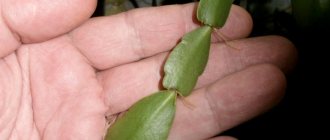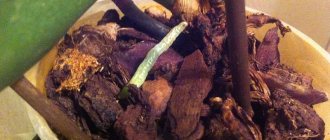Reproduction methods
There are the following methods of propagating ficuses: apical and stem cuttings, cuttings with one leaf and air layering. Small-leaved Benjamin ficuses are not propagated by cuttings with one leaf, as this is very difficult due to the small size of such cuttings.
Apical cuttings
During spring pruning of the tree, cut off upper parts of the shoots are formed, which can be rooted and young ficuses are obtained.
The cuttings should be more than 15 cm in length and have 2-4 large leaves. The branches from which they were cut should be semi-lignified.
To prepare a ficus cutting for rooting, you need to cut its lower part at an angle of 45º as close to the node as possible . The lowest leaf growing from this node is cut off with a knife, the remaining leaves are cut in half.
Prepared cuttings are placed in water for several hours so that the white juice does not solidify on the cut and interfere with root formation. After this, the cuttings need to be dried in air for 2-3 hours. Then they are rooted in one of 2 ways.
Methods for rooting cuttings
Ficus cuttings can be rooted in water or soil. The first method is the simplest. The cuttings are placed in a container with boiled water at room temperature so that their lower node is in the water. It is better to choose a container that is opaque or made of dark glass, so that blue-green algae, which prevents root formation, do not multiply in the water.
When rooting cuttings, it is necessary to maintain a temperature above 25ºС . High air humidity promotes rapid rooting. Usually roots appear within 3-4 weeks. When they lengthen to 4-5 cm, the cuttings can be planted in the ground.
Cuttings are often rooted directly in the soil. To do this, you can take a standard soil mixture for ficuses, which contains turf and leaf soil, peat and sand in a combination of 4:4:2:1.
Cuttings also root well in a mixture of peat and sand in a 2:1 ratio. For rooting you need a container with moist soil.
Ficus cuttings are buried into the ground by 1 node and covered on top with plastic wrap or glass jars. The substrate must be moist, and the air temperature during rooting should not be lower than 25ºC.
In such conditions, in about a month, young leaves will appear on the cuttings. After this, you can gradually remove the film from them so that they get used to the air humidity in a city apartment. When the cuttings actively begin to grow, they are transplanted into separate pots.
Stem cuttings
A long cut ficus shoot can be cut into pieces with 3-4 leaves.
These stem cuttings can also be rooted. They are prepared in the same way as apical cuttings, cutting off the lower part at an angle and drying the cut in air. Roots on stem cuttings form much more slowly than on apical cuttings , and many stem fragments do not form roots and disappear.
To increase the number of rooted stem cuttings, you can use drugs to improve root formation. If rooting occurs in water, the cuttings are soaked in a solution of the drug. If they are rooted in the ground, you need to powder the cut with stimulating powder.
Propagation by cuttings with one leaf
Thick shoots of rubber plants can be cut into short pieces with one node and one leaf.
The lower cut of such cuttings is made at an angle in the middle of the lower internode, the upper cut in the middle of the upper internode. The ficus leaf is rolled into a tube and secured with an elastic band or adhesive tape.
Prepared cuttings with one leaf are rooted only in the ground . They are buried in damp soil up to the petiole of the leaf. The temperature for rooting them is the same as for rooting other cuttings. To create constant air humidity, the container with the cuttings is covered with film.
Formation of air layering
An aerial layer is a part of a ficus shoot with formed aerial roots, which can be cut off and planted in the ground.
To form aerial roots, make 2 circular cuts on the ficus branch at a distance of 1-2 cm from each other . The bark between them is carefully removed, and the bare area is sprinkled with rooting powder.
How to plant a ficus cutting: rules for rooting and planting
- June 10, 2019
- Planting
- Efimova Anastasia
Ficus is a legendary plant for our country. About 300 years ago it could only be found in private greenhouses. After 150 years, the plant became a decoration for the front rooms of any wealthy person, and after the revolution, the ficus firmly established itself in the homes and various public institutions of Soviet citizens. And today, a green bush with dark waxy leaves can be found everywhere - in apartments, hospitals, schools and offices.
Ficus is unpretentious and tolerates lack of sunlight well, which is especially important for our latitudes. There are also usually no problems with propagation and transplantation. Growing a ficus from cuttings is a simple task that even a schoolchild can handle.
All home ficuses can be divided into three large groups:
- Tree-like. Tall, up to three meters high. The leaves are large, up to 20 cm long and up to 5 cm wide. The shape and color of the foliage depends on the specific species.
- Ampelous. Creeping liana-like plants. They are characterized by a high growth rate and an acute reaction to lack of water (they die easily). Representatives: mountain ficus, creeping ficus.
- Shrubs. Medium height, with oblong pointed leaves 8-10 cm long. There are variegated varieties.
Bald ficus benjamina: how to help grow rich leaves again
Want to help your pet become beautiful and green again? Small changes in care will help. Yes, Ficus Benjamin is good for everyone, except for one small feature that consistently upsets flower growers around the world. As soon as the plant doesn’t like something, it will immediately and categorically let you know by defiantly throwing off some of the leaves or completely reducing itself to the state of branches.
.
But the sad process is reversible for the ficus. Practice has shown that after dropping even 95% of the crown, the bush can become fluffy again. After reading the article to the end, you will learn how to turn back the “rivers.”
Features of cuttings of various types of ficus
Ficus trees are so diverse that there are no uniform rules or recommendations for their propagation. For example, creeping or low-growing ficuses (Pumila minima, Pumila macrophylla, Variegata, Sunny, White sunny) are propagated by cutting off the apical part of the shoot with 3-4 leaves or the entire shoot at the very root.
Then one or more vines are planted in a small glass, 7-8 cm in diameter, filled with soil mixture. While the cuttings are taking root, they need shelter, warmth and daily spraying.
One of the most popular types of ficus benjamina (Ficus benjamina) takes root well in water, although you will have to wait quite a long time - about a month.
“Waste” after pruning an adult tree is perfect for cutting cuttings.
When planting shoots directly into the ground, it is better to use a mixture of sand and peat. Rooting seedlings must be covered to create a moist, warm microclimate. Cuttings with roots are transplanted into pots with a diameter of 9-10 cm filled with a soil mixture of three parts turf soil and part peat, to which a little river sand is added.
Variegated varieties of Benjamin (Bushy King, Golden King, Exotica, Reginald, Natasha, Starlight) are cut only with the onset of warm weather, using apical or lateral shoots to prepare cuttings. When rooted in water, roots appear after 2 or 3 weeks.
Rubber-bearing ficus (Decora, Robusta, Variegata, Black Prince, Melany, Tineke, Schriveriana), which is also called elastic ficus or rubber fig, is one of the few types of ficus that can be propagated at home from seeds. But this is a troublesome task and not always successful - often seedlings do not retain varietal characteristics.
It is much easier to grow rubber plants from cuttings. Suitable for harvesting are apical and lateral shoots, leaves with a heel, or just shoots with a bud.
The most suitable time for cuttings from elastic ficus is March-April. The treated cuttings are buried in damp river sand or expanded clay. The root system is formed in 1-1.5 months. When rooted in water, the roots germinate faster - in 20-30 days.
Lyre-shaped or violin-leaved fig (Ficus lyrata) is distinguished by very large (20-60 cm) leaves, is quite whimsical and capricious, but it can also be propagated by cuttings. 12-15 centimeter cuttings harvested in spring must have at least four leaves. Cuttings are rooted in water or soil and germinated following general rules.
Transplantation: new soil will give the ficus new nutrition
The second half of winter and March are the best times to replant most indoor plants. It is needed if the roots of the ficus have already begun to peek out from the drainage hole of the pot or the soil has begun to dry out too quickly.
Young ficus trees are replanted once every 1-2 years. As the roots entwine the earthen lump. Adult specimens - once every few years.
Careful transshipment, preserving the earthen clod entwined with roots, and adding new soil will provide the plant with nutrients
. And the new pot is a place for roots to grow.
Advice from the author
: If you do not have the opportunity to transship, simply renew the top layer of soil
Features of rooting cuttings in water
For this event you will need a glass container with a dark tint. This will limit the access of sunlight to moisture, which promotes the development of algae (water blooms). If the container is transparent, it is wrapped in thick paper.
Ficus shoot
For rooting ficus, use filtered or boiled water, slightly warmer than room temperature. A piece of charcoal or activated carbon is added to it. It is an excellent antiseptic and stimulator of root formation.
Only the stem of the cutting is immersed in water. Water getting on the leaves leads to rapid rotting. To maintain the plant at the required level, you can cut a circle of foam with a hole for the stem in the middle. It is placed on the surface of the container and the end of the cutting is lowered into the water through the hole.
A mini-greenhouse with periodic ventilation is also equipped for the plant. Add water as it evaporates. After 5-10 days, the formation of white growths - callus tissue - can be observed on the cut of the cutting. After the roots reach 2-3 cm, the cuttings are transplanted to a permanent place of development.
It is not recommended to keep the plant in water longer. Ficus roots develop slightly differently in water than in soil. They are covered with fluffy root hairs, which, when placed in a substrate (in a drier environment), gradually begin to die off. Therefore, it is important to transplant the cuttings before the roots develop to a large volume.
Throwing away pity: life-giving pruning
New leaves will no longer grow in place of fallen leaves. But leaves will appear on young shoots. To stimulate the growth of new branches from the buds, you can do simple pruning.
I cut all ficus branches affected by botanical alopecia exactly in half
. At the same time, out of 2 shoots growing close and parallel to each other, I leave one. So that they don't interfere with each other. If something grows inside the bush, you can also cut it off: this way the entire bush will be well illuminated by the sun.
Briefly about watering
Overwatering a ficus is much more dangerous than drying it out. Moreover, a sad rule works: the fewer leaves, the smaller the area for moisture evaporation. Therefore, bald Benjamin needs very, very careful and meager watering! Be sure to ensure that the top layer in the pot dries completely.
For obvious reasons, it is better to postpone watering from the shower. But spraying and wiping the surviving leaves will be beneficial.
Author's advice
: A “hot shower” for a bald ficus can awaken dormant buds. But you need to water so that almost no water falls on the ground. For example, tilting a pot.
How to propagate ficus by air layering
Substrate For very young ficuses, a light and permeable soil mixture is traditionally made up of leaf soil, peat and sand in equal proportions. Adult ficuses require denser soil, so turf soil and humus are added to the substrate.
A good drainage layer of expanded clay and pieces of charcoal in the soil will protect the plant from stagnant water and rotting roots. Dormant period Almost all types of ficus from October to February are characterized by a forced dormant period associated with a lack of light and a decrease in temperature.
Fertilizer Regimes and rates of fertilizer application depend on the substrate and time of year. When growing ficus in an inert substrate, fertilizers are applied year-round. Vegetation during this period is undesirable, since there is not enough light, heat and moisture, and stimulating the ficus to grow leads to the formation of weak and elongated shoots.
Hello. Please tell me what should I do with my cuttings? I transplanted them into a small pot of cactus soil. Now I don’t know whether these “pimples” have rotted for some reason and there’s no point in waiting for roots at all, or just wait for now... If the cutting looks normal, then it will definitely give roots - where should it go?
Ficus benjamina. This species is propagated by cuttings. In winter, ficus is not fertilized. Roots formed in water take a long time to get used to the soil and can generally die off, this happened to me, especially in ficus with leaves with white edges. Faster rooting occurs if the cut ficus cuttings are immediately placed in a mini-greenhouse. If the ficus has grown to the ceiling, and the leaves remain mainly only at the top, then you can simply shorten it.
seriostyn.ru
The most important thing is the weather in the house
I’ve probably already tired you with a long text, although I tried to write only the most important things. Now, in a short list, I will list the ideal conditions for the growth of new branches and leaves of Ficus Benjamin:
- sunny window (especially important for variegated varieties);
- absence of cold drafts - while the temperature outside is low, try to move the pot away from the glass;
- You should not constantly rearrange and twist the plant - to ensure that the crown grows evenly, periodically turn the pot a few degrees.
I hope that my tips will help your ficus regain its former beauty. Do you love The Benjamins and was the article helpful? Please give her a thumbs up in return! Thank you
.
And owners of other decorative foliage flowers may find this article useful: Zamioculcas does not tolerate: common mistakes of beginners
Ficus propagation at home
Ficus will survive wintering better in a warm and dry living room if it is provided with additional lighting and spraying. You should not set a strict schedule for watering your ficus, since external conditions (lighting, temperature, humidity) are constantly changing, affecting the intensity of moisture consumption by the plant. Bottle ficuses Ficus palmeri (Ficus palmeri), Ficus petiolaris (Ficus petiolaris) require strong drying of the soil between waterings to form a thickened trunk.
When can ficus benjamina be propagated?
Ficus is one of the popular house plants used to decorate the interior. Intensive growth of shoots and bright green foliage will transform a room for any purpose. Culture looks great in a small apartment and a large country house. This exotic beauty won the hearts of flower growers not only with its high aesthetic qualities, but also with its undemanding care. The culture also has beneficial properties, which are expressed in the ability to purify the air from dangerous chemical compounds (benzene, trichlorethylene, phenol, etc.).
The flower is easy to propagate using one of the available methods. It is better to plan these events for spring or summer. In autumn there begins a period of rest. Until spring comes, the plant rests and gains strength. At this time, the production of new shoots and foliage is reduced. You should not injure the ficus by cutting cuttings or leaves; there is a high probability of weakening the protective function.
Reference! The favorable time for transplanting ficus is considered to be the period from May to August.
Selection of timing and shoots for cuttings
It is important to carry out any interventions in ficus tissue taking into account its biological characteristics. This is the main condition on which the restoration of the mother plant and the degree of rooting of the cuttings depend. The quality of planting material and correct planting determine the resistance to disease and temperature conditions of the new plant.
Ficus transplant at home
The event is planned for early spring, when the intensity of sunlight increases. During this period, increased metabolism and formation of phytohormones occur in the ficus tissues, which stimulate the growth of new roots. After planting the ficus in March or early April, the plant will have enough time to strengthen its roots until autumn.
An important condition for the rooting of shoots is the complete ripening of the shoots. This process can be stimulated artificially. To do this, 15 days before cuttings, stop watering the ficus and moisten the plant with an aqueous solution of charcoal (20g/10l).
Depending on their location, ficus shoots have different properties. The closer the shoot is to the growth point, the better the stage changes occur in them. This means that planting material from the top of the plant will take root, develop and bloom faster.
Therefore, for rooting, it is not uncommon to choose the apical shoot, or, in extreme cases, shoots from the middle part of the ficus. A prerequisite is a healthy leaf bud on the top of the cutting.
Reproduction methods
Ficus benjamina can be propagated using one of the possible methods.
Cuttings
This method involves the use of lignified shoots. The length of the workpiece should be 10-15 cm. If the cutting is a little lower or higher, it’s not a big deal. When planting a thin base, you will need to install a support.
Cut shoots should be placed in water. While the cuttings are cleared of milky juice, you should choose a rooting method. The milky juice should be removed by soaking the cut. If it is left on the cutting, the frozen crust will interfere with the formation of roots and new shoots.
By layering
If the plant produces a small increase in shoots, you can use the layering method to propagate the ficus. To get a new flower, follow these steps:
- On the mother plant, a shoot 40-50 cm long is selected.
- The place where it is planned to grow roots is marked on it.
- Remove 2-3 sheets in the selected area.
- Make two circular cuts in the bark, keeping an interval of up to 3 cm between them.
- Remove the bark in the intermediate area.
- Apply Kornevin to the exposed part of the shoot.
- Fix sphagnum moss in this place and moisten it with a spray bottle.
- Cover this area with a strip of polyethylene and secure the twist with threads.
- Periodically check the moisture level of the moss. If necessary, it is sprayed with warm water.
- After root branches appear around the moss, the cuttings are cut below the level of the root system.
- The resulting layering is planted in a separate pot. And the place where the mother plant is cut is treated with a solution of activated carbon and wax.
The process of obtaining layering takes approximately 2-2.5 months. If you follow the moisturizing regime, the result is always positive.
Leaves
This method is only called leaf, but to harvest planting material, a leaf plate with a petiole and a small part of the stem are required.
The first cut is made under the bottom leaf. Make a 1 cm indent from it. Then 1 cm indent from the cut line and make a cut off again. The next cut is made above the second leaf. As a result, you get as many blanks as there are cut fragments with leaves.
After soaking the cuttings to remove the milky juice, they are buried in the soil mixture. Choose a pot that is spacious enough to accommodate all the cuts. Drainage is introduced into the bottom of the container in a layer of 3-4 cm. The substrate is chosen to be light and loose. The most successful option is a composition based on peat and fertile soil. The shoots are buried in the soil to the base of the petiole.
The blanks should be placed along the edge of the container so that the sheet tilts slightly over the sides. For quick rooting, the planting is covered with polyethylene or a glass vessel and moistened periodically. The process of forming the root system takes approximately 2-3 months. After this, the young plant can be replanted.
Seeds
You can even grow ficus benjamina using seeds. They are very small, so they use a magnifying glass and a wooden stick for sowing. The period favorable for germination of planting material falls in February - April. In the absence of heat, the time is extended until July.
Reference! During the process of growing seedlings, artificial lighting may be required to increase daylight hours (it should be at least 10-12 hours).
For planting, choose a shallow container, which is filled with a mixture of sand and turf soil. The substrate is not filled to the edges (the sides are left 3-5 cm). The surface of the soil mixture is moistened with warm water from a sprayer. Lightly pat down the improvised bed with the palm of your hand.
Place seeds onto the prepared substrate with a stick, trying to distribute them evenly throughout the container. To keep the grain on the edge of the stick, it is first moistened in water.
The planting is sprinkled with fine-textured soil, creating a 3 mm layer. To retain moisture in the soil, a polyethylene frame is installed on the top of the container. In a greenhouse environment, seedlings should appear after 5-8 weeks.
How to care for the plant after the procedure?
- Lighting . Ficus is a fan of diffused light, so it does not tolerate direct sunlight. Experienced gardeners recommend choosing the western or eastern part of the apartment for placing the plant.
- Temperature . Comfortable conditions for a flower are a room in which the temperature is maintained at +20–25 degrees. In the winter season, the thermometer should not fall below +15, this can lead to the death of the ficus.
- Humidity . It is necessary to humidify the air using a spray bottle. As for winter, you can get by with simply wiping the leaves with a damp cloth. Water procedures must be carried out exclusively with settled water. Protect the flower from drafts.
- Feeding . It is necessary to feed the flower at least twice a month, during the period of active growth. To do this, you should add complex fertilizers in a liquid state. It is important that it contains nitrogen.
- Watering . Moistening the soil is necessary as the top layer dries. In winter, ficus should be watered once every 7 days, and in hot weather - 3-4 times during this period.
In order for a ficus to feel comfortable at home, it requires proper care and certain knowledge of the owner about the intricacies of the flower. However, ficus can successfully grow in public places. The main thing is that for the flower to develop correctly, it is necessary to maintain soil conditions, moderate watering and introduce timely fertilizing.
How to do it right
First you need to prepare everything you need. Do not forget about disinfection of the products used.
Required materials and tools
In the process of preparing cuttings you will need:
- mother plant;
- container;
- filler;
- container with water;
- pruning shears or sharp knife;
- alcohol solution or other disinfectant;
- root stimulator.
Step-by-step instruction
It is easier to complete the work of harvesting and rooting cuttings if you follow this sequence.
- First stage. Select lignified or semi-lignified shoots on the mother plant, the length of which reaches 5-15 cm. They should have 2-3 nodes. You can take cuttings from both the top and side branches.
- Second phase. Make an incision with pruning shears under the lower bud. In this case, the pruning shears are installed at an angle of 45°. Cuttings should be treated with a product that activates the development of the root system (for example, Kornevin). This will speed up the rooting process.
- Third stage. To remove the milky juice released at the cut site, you need to place the cuttings in a container with warm water. Soak the workpieces in the liquid for an hour.
- Fourth stage. Fill the container with sand or a mixture of peat and perlite. Other fillers are also suitable: perlite, vermiculite, sphagnum moss. After lightly moistening, plant the cuttings in a container.
- Fifth stage. The container is covered with a glass jar or glass. The workpieces are kept in a warm room at a stable temperature of 25-26°. Periodically, the filler is slightly moistened. After 2-3 weeks, the cutting produces thin root shoots.
Planting a shoot in the substrate
How to plant a ficus sprout? To root the cutting, you need to prepare a container 10 cm high. It is disinfected with a 3% formaldehyde solution. It is better to mix the substrate a few days before planting the cuttings. During this time, it is structured and saturated with moisture.
To do this, mix the components:
- peat 40%;
- river sand 40%;
- vermiculite 20%.
A ficus shoot that has a root
After this, pour with boiling water or a 1% solution of potassium permanganate.
Before planting the cuttings, the sections are treated with “Kornevin” (growth stimulant) or crushed charcoal. Planting material is buried to the level of the lower node in a moist substrate.
How to grow a ficus shoot? For rooting, ficus cuttings require high humidity of at least 85% and high temperature +28°- +30°C. This can only be achieved in a mini-greenhouse.
To do this, you will need a transparent plastic container of suitable volume, in which you need to make 8-10 small holes with a needle. Cover the cutting with it and place it in a well-lit place.
The ideal option is south-facing window sills with radiators located below, which will provide the required temperature.
During the rooting period, the greenhouse is ventilated twice a day for 15 minutes, morning and evening. Complete formation of ficus roots occurs on average after 30 days. This can be judged by the appearance of new leaves. During this period, ventilation is done every day, gradually increasing the time and accustoming the plant to indoor conditions.
Features of reproduction
Instruments used to work with the plant must be sterile. To do this, the cutting part is treated with an alcohol solution or other antiseptic. If cuttings are taken from different bushes, then disinfection must be carried out after each flower. This will prevent infection of healthy flowers.
In the ground
For rooting in the ground, a substrate is prepared from turf soil, sand and peat. All components are disinfected in the oven by heating. After this, they are mixed and introduced into the planting container.
Reference! Small pots are suitable for rooting 1-2 cuttings. If there are more blanks, it is better to use a rectangular container with appropriate parameters.
After cleaning the milky juice, the shoot is buried into the soil mixture by 2-3 buds. The soil is lightly compacted and moistened using a sprayer. To create a greenhouse effect, sticks are placed along the edges of the container, and a transparent plastic bag is fixed on top of them. The frame should be higher than the planting material. Successful rooting requires a warm environment and moderate humidity.
In water
Rooting cuttings in water is considered less troublesome. It is enough to place the blanks in a container with liquid. The container should not allow light to pass through, so when using a glass vessel, gardeners wrap the outer wall with foil or thick dark fabric. It is also necessary to build something similar to a greenhouse on top of the cuttings. The simplest option involves fixing a plastic cup.
When the cuttings are rooted in water, the microclimate is established close to the natural habitat conditions of ficus trees. This is a temperature within 25° and an average level of humidity.
Maintenance of an improvised greenhouse is kept to a minimum:
- 2-3 holes are made in the bottom of the plastic cup for free passage of air;
- As the water evaporates, make gravy;
- After the roots appear, the structure is dismantled for subsequent transplantation of the shoot.
Pot and soil mixture
For ficus plants, choose pots that are medium in height and width. The size of the container is determined by eye, based on how much and how quickly the roots grow. The best option is when the diameter of the pot is slightly larger than the roots.
The inside of the container should be smooth so that the roots do not grow together with the walls. Otherwise, they can be easily damaged during transplantation.
The soil for ficus plants is mixed: 4 parts each of turf and deciduous soil and one part each of sand and peat. The result should be a loose, not heavy mixture with good water permeability.











